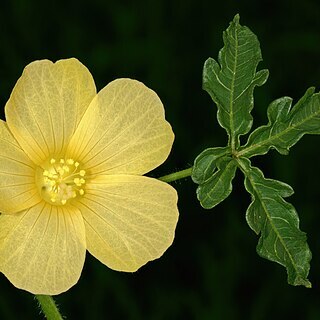A shrub. It has a woody rootstock and keeps growing from year to year. The branches are long, slender and straggling. The stems are rough and have hairs. The leaf blades have 3-5 deep lobes. The leaves are heart shaped at the base. The middle lobe is 1.5 cm wide. The flowers are yellow. They are 4 cm long.
Prostrate perennial herb. Epicalyx of 7 or 8 bracts, filiform. Valves of capsule with 2-3 mm long awns. Seeds appressed-pubescent. Flowers pale yellow or yellow, with or without dark centre.
Perennial ± prostrate herb; stems rather sparsely to densely setose or setulose and often with a longitudinal line of pubescence changing its radial position at each node.
Calyx 10–15 mm. long; lobes sub-scarious, triangular or narrowly triangular, joined for 2–3 mm. at the base.
Staminal tube c. 6 mm. long; free parts of filaments 3–5 mm. long; style-branches 3·5–4 mm. long.
Capsule 8–9 mm. in diam., subglobose, sparsely pubescent; valves with awns 2–3 mm. long.
Flowers 3·5–5 cm. in diam., pale yellow or yellow, with or without a dark centre.
Epicalyx of 7–8 bracts; bracts 12–15 mm. long, ± filiform or narrowly linear.
Seeds 3 × 2 mm., angular-subreniform, appressed-sericeous-pubescent.
Petals 3·5 × 2 cm., obliquely obovate, glabrous.

